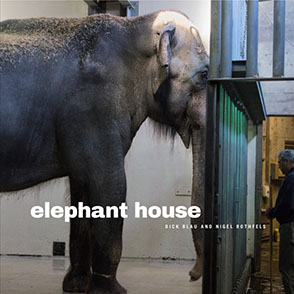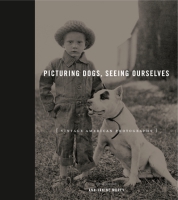Elephant House
Dick Blau and Nigel Rothfels
“You think you know all there is to know about elephants in captivity? Think again. Setting aside the familiar screeds and sentiments, Dick Blau and Nigel Rothfels offer a deep, multidimensional, and nuanced understanding of our relationship to zoo elephants, one that will challenge the animal rights critic and zoo advocate alike. The wonder and sadness evoked by the checkered history of elephant exhibition, the difference and commonality that bind these majestic animals to the people who care for them—it’s all here. You may not change your mind about the keeping of elephants in captivity after reading this book, but you’ll see the fuller picture. And it will be impossible to come away from Elephant House unmoved.”
- Media
- Description
- Reviews
- Bio
- Table of Contents
- Sample Chapters
- Subjects






Blau’s evocative photographs are complex and challenging, while Rothfels’s text offers a scholarly and personal response to the questions that surround elephants and captivity. Elephant House does not take sides in the debate over zoos but focuses instead on the bonds of attentiveness between the animals and their keepers. Accompanied by a foreword from retired elephant keeper Mike Keele, Elephant House is a frank, fascinating look at the evolving world of elephant husbandry.
“You think you know all there is to know about elephants in captivity? Think again. Setting aside the familiar screeds and sentiments, Dick Blau and Nigel Rothfels offer a deep, multidimensional, and nuanced understanding of our relationship to zoo elephants, one that will challenge the animal rights critic and zoo advocate alike. The wonder and sadness evoked by the checkered history of elephant exhibition, the difference and commonality that bind these majestic animals to the people who care for them—it’s all here. You may not change your mind about the keeping of elephants in captivity after reading this book, but you’ll see the fuller picture. And it will be impossible to come away from Elephant House unmoved.”
“These photographs are mesmerizing. . . . Blau’s photographs do not return us to a state of innocence with these animals. While the tenderness with which they are cared for is clear and their alert intelligence undeniable, these images haunt us because they forcefully convey how different this consciousness is from our own. Their intelligence, together with their beauty and magnificence, for a brief moment relieves us of our egoistical insistence on our imagined primacy as a species.”
Dick Blau, a photographer and filmmaker, is a coauthor of Skyros Carnival, Bright Balkan Morning, and Polka Happiness, three photo-ethnographies that look at the transformative power of music and dance. His work on familial emotion is featured in Jane Gallop's Living with His Camera, readings in the theory of domestic photography.
Nigel Rothfels is a historian of animals and culture. He is the author of Savages and Beasts: The Birth of the Modern Zoo, which examines the origins of naturalistic displays in zoos; the editor of Representing Animals, a foundational interdisciplinary collection in the field of animal studies; and the editor of Animalibus, Penn State Press’s scholarly series about animals and culture.
Contents
Foreword
Mike Keele
Elephant House
Nigel Rothfels
Photographs by Dick Blau
List of Photographs
Acknowledgments
Foreword
Mike Keele
When Nigel and Dick proposed this project to the Oregon Zoo, I was excited, as I saw this as an opportunity to tell the story of elephant care in a new but also historically accurate way. How have caring individuals been able to provide for the daily mental and physical needs of these magnificent animals while advocating for needed changes in the facilities, changes that have made it possible for care to improve over the years? So, to me, the story of this book is not simply about a state-of-the-art building that must eventually come down, but also about how caring individuals made that happen and how their work has resulted in a better future for the elephants. And this metamorphosis did not just happen at the Oregon Zoo; it happened at many U.S. zoos that care for elephants, each institution urged on by the advocacy of its own care personnel. These are extraordinary individuals who speak to and for the elephants.
I began my career at the Oregon Zoo in 1971 and began working full-time with the elephants in 1975. The zoo provided me with wonderful opportunities during my career, and foremost among them was my work with the elephants. When I started, the zoo had a family of nine elephants, and an elephant birth was a fairly common event. Between 1962 and 1975, fifteen elephant calves were born in Portland, causing one local newscaster to wonder whether the zoo would name its most recent baby “Enough.” What that reporter didn’t realize was how rare zoo-born elephants were, as no other elephants had been born anywhere in North America but in Portland since 1918. I spent many nights at the elephant house, waiting for an expectant mother to deliver her calf. In retrospect, it wasn’t that we needed to be there to assist the elephants with the birth, because by that point they were very experienced mothers. We were there, I know, because we wanted to witness the extraordinary event of the birth and see how the cows worked together to help the newborn, thereby creating even closer bonds among themselves. At times, the behavior seemed a bit frantic, but it wasn’t: we were just witnessing excited elephants being elephants.
Part of the zoo’s Asian elephant breeding success was due to the facilities that allowed for the safe management and care of adult bull elephants. Bulls are powerful and often aggressive, making them dangerous to work around. A six-ton elephant can really do a lot of damage to a facility that hasn’t been engineered to withstand powerful ramming, a trunk that can reach great distances, and an animal capable of standing on its hind legs to “tinker” with light fixtures or ductwork. Portland’s elephant barn addressed these challenges with a lot of concrete. This functional facility was never exactly aesthetically pleasing, yet as unaesthetic as it may have been, the building had its advantages. It allowed the elephants to free-range throughout the day and night, when elsewhere in the country it was necessary to chain the elephants overnight to prevent them from demolishing the buildings.
When I first worked with elephants, I quickly learned that each had a unique personality. I became friends with the females, and my favorite was Pet. Unlike the other cows in her herd, she was not competitive, choosing to be the lowest cow of the pecking order—a position that is also the least stressful. Pet and I developed our own greeting: she would come up to me and lower her head. I would rub and scratch the inside of her front leg, and she would put her ear out so that my head was behind it. I would then talk to her softly and scratch the back side of her ear while she lowered her head even more. We did this often; she seemed to like it, and I know I did.
Pet didn’t like us to trim her feet. We guessed that someone had hurt her once. But I was patient and relied on our friendship, and eventually, I had Pet’s full cooperation for foot trims. It was a trust issue; Pet trusted me to be gentle with her while I was caring for her feet. And treating her gently paid off by strengthening our friendship. When I was no longer a caregiver, I would visit the elephant barn and sometimes get to be with the elephants. Pet never forgot me. She would engage me in our greeting, and that would be a very special day for me. We had our final greeting one week before she died in 2006, but she left me with a lasting memory, and I hope her life was made easier by the improvements we made during her time with us. I would wager that almost all elephant caregivers have similar stories about animals they considered particularly special.
Several images in Elephant House capture moments between people and elephants that are both rewarding and challenging: rewarding, because at the end of the day you feel as though you’ve made a positive difference in the lives of the elephants in your care; challenging, because you always feel that there is more you can do. It is because we have been trying to do better over a very long time that an elephant facility that was “state of the art” over fifty years ago has undergone repeated changes and is now being closed. Over the years, the facility’s footprint expanded twice; concrete and asphalt were replaced with natural substrate; concrete interior flooring was cushioned; dangerous moats were removed; and an elephant squeeze chute was installed. That chute, which appears in some of these photographs, was the first of its kind in North America, and it allowed the zoo to provide much better and safer care for the bull elephants. All of the improvements I have listed were intended to improve the care of the elephants—not to improve the exhibit experience for the zoo visitor. The indoor spaces in the elephant barn function, as designed, to meet the care needs of the elephants, but these spaces can make zoo visitors today feel uncomfortable. That discomfort is part of the process of improving our facilities for the public and the animals. As our expectations for our facilities have changed over time, so too have the facilities. When I look at the images in this book, I see the facilities as they were when the pictures were taken, but I also see them in the ways they have changed over the years. I am proud that this zoo has such a strong tradition of ongoing improvement.
By the time this book comes out, the old elephant house will have been demolished, and a new complex for the elephants will have been opened. The new facilities are designed to make it possible for the elephants to make more choices about how they spend their day. This will result in their activities being more elephant directed and less human directed. There will be more choices about social interaction, exercise, browsing, bathing, resting, and other activities. The new Elephant Lands exhibit incorporates all that we have learned over the years about caring for elephants, and much of that we learned from the old elephant house of this book.
I retired from the Oregon Zoo in 2014 after forty-two years. Elephant House is perhaps especially important to me because it serves as a sort of scrapbook, reminding me of all that has been done over the last fifty years to improve the care we provide for our elephants. For others, though, I hope that this book provides a little insight into the relationships between people and elephants that are at the heart of both this project and the elephant house itself. The old elephant house is gone now, but these images will always remind me of the privilege I had to work in this building with such extraordinary friends.
Mailing List
Subscribe to our mailing list and be notified about new titles, journals and catalogs.





